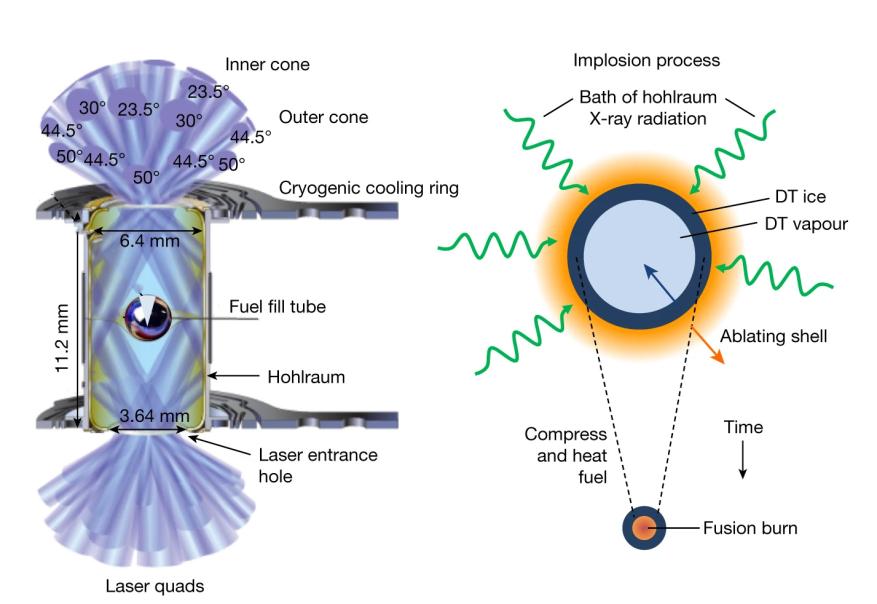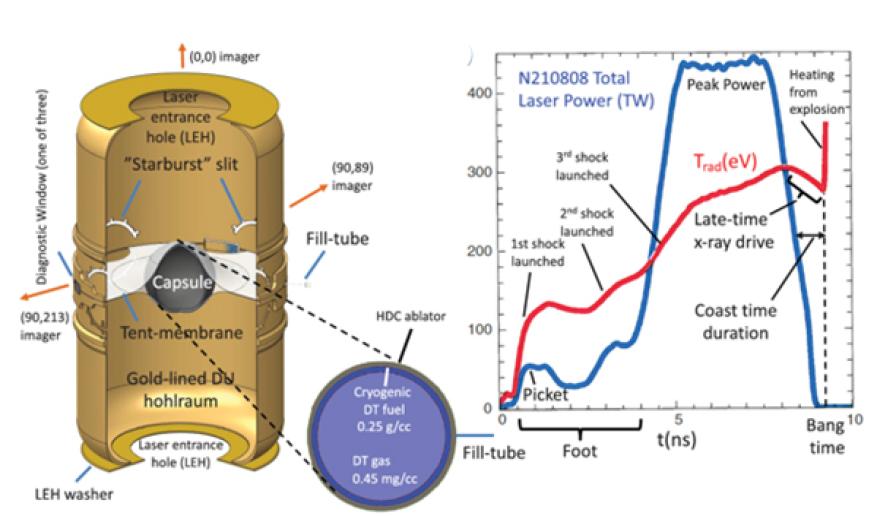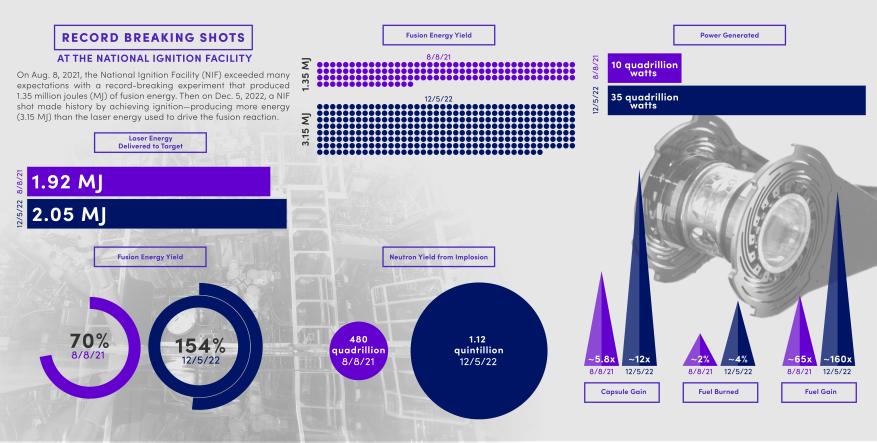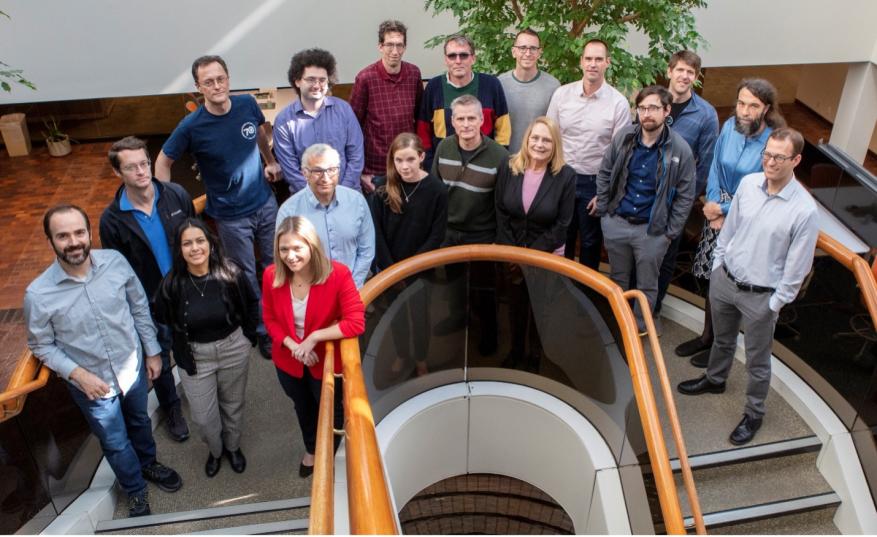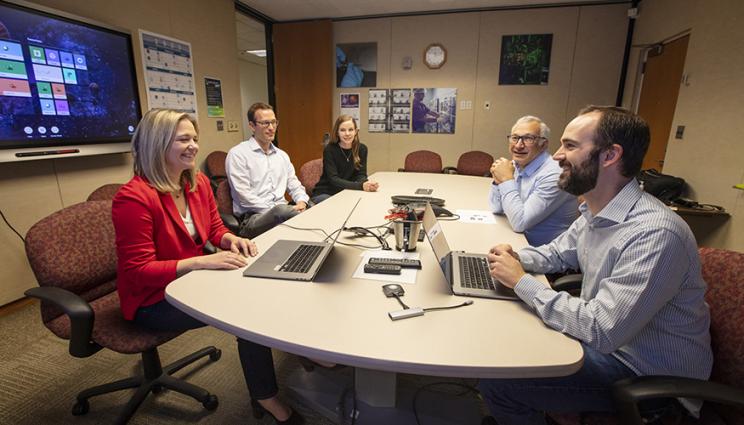
Experimental Design Team members discuss the results of the Dec. 5 ignition experiment. From left: Annie Kritcher, Chris Young, Kelli Humbird, Omar Hurricane and Chris Weber. Credit: Jason Laurea/LLNL.
Second in a series of articles describing the elements of the National Ignition Facility's fusion breakthrough.
Part 1: Star Power: Blazing the path to fusion ignition
The National Ignition Facility (NIF) is the world's biggest laser - three footballs fields could fit inside - but it's what happened inside a capsule the size of a peppercorn that made scientific history on Dec. 5, 2022.
The NIF experiment that produced fusion ignition in a laboratory for the first time and made news headlines around the world was anything but an overnight success. The accomplishment was the result of decades of research to determine the laser requirements and target conditions necessary to create a fusion reaction that produced more energy than was needed to spark the reaction.
NIF's steady progress from a few kilojoules of energy yield when the facility began ignition experiments in 2011 to the December breakthrough was due in large part to the steady evolution of NIF's experimental designs - closely coupled with continuous improvements in diagnostic, optics and simulation technology, target quality, and the energy, reliability and energy balance of NIF's 192 laser beams.
"Achieving ignition requires a great deal of finesse. Although these changes seem small, they make all the difference." - Lead Designer Annie Kritcher
"Our pursuit of fusion ignition over the past decade at NIF was an incredibly ambitious technical goal," said LLNL Director Kim Budil. "Many said it was not possible - the laser wasn't energetic enough, the targets would never be precise enough, our modeling and simulation tools were just not up to the task of this complex physics."
To put those doubts to rest, the researchers modified the elements of NIF's experiments - the size, shape and composition of the targets, the shape and energy of the laser pulse, the timing of the implosions - as they gradually gained more understanding of the inertial confinement fusion (ICF) physics that could enable a self-sustaining "burn wave" of fusion reactions that would lead to ignition.
Improvements in steps
Annie Kritcher, the experiment's lead designer and team lead for integrated modeling, said the experimental design process has involved "many years of building up understanding and developing models and cross-checking those models against experimental data, and then using those calibrated models together with semi-analytical models and theory to make design improvements."
The key steps along the path to ignition included:
- Designing and experimenting with the energy, shape and duration of the laser pulse to improve the stability and velocity of NIF implosions.
- Changing the composition of the target capsule, the ablator, from polymer (CH) to high-density carbon (HDC), or diamond, to improve energy efficiency and ablation pressure.
- Launching a series of "Hybrid" (high-yield big-radius implosion design) experiments that coupled the best elements of previous high-yield experiments with new understanding of the implosion process provided by rapid advances in diagnostic and modeling technology.
- Increasing the size of the diamond capsules and modifying the size and configuration of the hohlraums to deliver more energy to the hot spot in the center of the capsules where the fusion reactions begin.
- Modifying the design to enable the target changes with the same laser driver capability while maintaining high hot-spot energy density.
- Reducing the amount of helium gas in the hohlraums to inhibit backscatter losses and energy-robbing hot-electron production.
- Improving energy distribution and implosion symmetry by adjusting the balance of energy among the laser beams, both at the start of the laser pulse and when the beams cross in the laser entrance holes.
"Controlling the symmetry in these implosions is like trying to compress something the size of a basketball down to the size of a pea and keep it looking like a sphere to the percent level," Kritcher said. "This lets us squeeze the hot-spot plasma (a mixture of ions and free electrons) to conditions more extreme than the sun's core.
"We're trying to do this in a very harsh environment," she added, "where the target is filling with plasma and it's difficult to get all the laser beams where you want them to go to create a uniform X-ray oven."
In the end, it was vanishingly small, intentional energy-balance adjustments, coupled with a 6-micron (millionth of a meter) increase in the thickness of the capsule and a .13-megajoule (8 percent) boost in the lasers' energy, that resulted in the first ICF reaction to achieve ignition - producing 3.15 megajoules (MJ) of fusion energy from a laser input of 2.01 MJ.
"Achieving ignition requires a great deal of finesse," Kritcher said. "Although these changes seem small, they make all the difference."
"We had a debate over a laser setting equivalent to five trillionths of a meter going into this experiment," added principal experimentalist Alex Zylstra. "We had a discussion with the laser science team over a timing discrepancy of 25 trillionths of a second. Small timing errors, a billionth of a second, would be an eternity for us in this experiment."
"What ended up working was not some dramatic departure from what we had been doing," said ICF Chief Scientist Omar Hurricane. "It was much more incremental - thinking about these incremental changes and making improvements that moved us in the right direction."
On the threshold
NIF's first major breakthrough in energy yield came on Aug. 8, 2021, when a Hybrid-E experiment produced about 1.35 MJ of fusion energy - about 70 percent of the 1.92 MJ of laser energy delivered to the target - putting NIF at the threshold of ignition. That accomplishment came just a few months after NIF for the first time achieved a "burning plasma" - when the fusion reactions are the primary source of heating in the plasma.
To reach the 1.35 MJ milestone, the researchers shrank the aperture of the hohlraum's laser entrance holes to prevent energy from escaping during the experiment; re-adjusted the x-ray oven symmetry; reduced defects in the target capsule that contributed to "mix," or contamination of the central hot spot by capsule material; decreased the size of the tube used to fill the capsule with hydrogen fuel from five to two microns; and extended the laser pulse to effectively hold the implosion together longer and concentrate more energy in the hot spot.
Creating a NIF ICF implosion is a highly inefficient process; normally only 10 to 15 percent of the initial infrared laser energy reaches the capsule. About half of the energy is lost when the infrared light is converted to higher-energy ultraviolet; half of the remainder is used to create x rays in the hohlraum; and much of the rest is dissipated when x-ray energy escapes through the laser entrance holes or is lost to laser-plasma interactions, backscatter and other factors.
Doubling the hot-spot energy had been shown to increase NIF's energy yield by a factor of four; that's why finding ways to increase the energy absorbed by the hot spot was a key element of the experimental designs that produced both the 2021 result and fusion ignition in 2022.
"By increasing the amount of energy delivered to the hohlraum from the laser," Hurricane said, "we are reducing the implosion's coast time [the time between maximum compression and the end of the laser pulse]. That's a very strong lever.
"The radiation temperature in the hohlraum stays higher at late time than it would have if we had a very long coast time," he said. "That helps keep the implosion compressed. It's a really good benefit."
Short of the goal
The 2021 shot was the scientific equivalent of reaching the red zone on a football field. The drive to the goal line, however, stalled during the following year; several follow-up experiments were unable to replicate the Aug. 8 result.
"All the measured degradations were roughly equivalent to losing 10 percent of the energy in the hot spot just before it could ignite." - Senior physicist Laurent Divol
To gain a better understanding of the origins of the "inherent variations" that were hindering NIF's performance, LLNL researchers and their colleagues from the ICF community convened a series of workshops to examine the results of the follow-up experiments.
A careful analysis of those experiments, including a statistical analysis of the data, enabled the team to quantify the degradation mechanisms and identify the sources. The leading degradation mechanisms were implosion asymmetries and microscopic defects in the capsules that caused the capsule material to mix into the fuel.
"Asymmetries in the implosion reduce the transfer of energy from the [capsule] shell to the reacting plasma," said Arthur Pak, team lead for stagnation science. "This reduces the temperature and compression that can be achieved in the DT plasma, making it more difficult to ignite. Likewise, ablator material that mixes into the plasma increases the radiative loss, cooling the plasma and making it harder to ignite.
"Minimizing these degradations was critical to achieving ignition," Pak said.
LLNL computational physicist Marty Marinak, leader of the HYDRA multi-physics radiation hydrodynamic code used to design and model ICF experiments, added that high-resolution 3D capsule simulations "indicated it was essential that we develop a more robust design to achieve ignition. This code, assisted by theoretical and data-driven models, was used to optimize the new target design to achieve greater robustness."
A modified design
To deal with the variability issues, the researchers modified the Hybrid-E design by increasing the laser power by 8 percent, to 2.05 MJ. The new "Hybrid-E High Energy" (HyeHE) design also called for an 8-percent thicker capsule that could effectively use the extra energy and better protect the fuel from instability growth.
Kritcher said the design was generated using "a combination of complex radiation hydrodynamic simulations using the HYDRA code, analytical scaling, and semi-analytical models that were benchmarked against experimental data." These were used to determine how much thicker to make the capsule with a given laser energy upgrade as well as how to improve the symmetry.
"Using the extra laser energy to drive thicker capsules is better for stability and more fuel burn-up," she said.
"A key understanding from the variability study," said LLNL senior physicist Laurent Divol, "was that all the measured degradations were roughly equivalent to losing 10 percent of the energy in the hot spot just before it could ignite.
"This gave us confidence that we could return to yields above 1 MJ if NIF could deliver 10 percent more energy - and that energy coupled well to the hotspot. Simple scaling and simulations predicted that combining more NIF energy with a good quality implosion should produce an even higher yield…and it happened on the second try!
"Future work is focused on further improving the energy coupling and compression of the implosions," Divol said, "which will make the experiments more robust and less sensitive to these degradations."
"Even when we had struggles with the engineering, the physics, and the perceptions - just having the grit to stick with it really paid off." - ICF Chief Scientist Omar Hurricane
But boosting NIF's energy even further beyond its design specification of 1.8 MJ (the "threshold" shot had reached 1.92 MJ) was not without risk - such as possible damage to the laser system by light backscattered from the target.
"To date, the highest-performing NIF shots have leveraged wavelength tuning that modifies where laser power is deposited within the target and controls implosion symmetry," said design physicist Tom Chapman. "This technique can further raise the potential of producing damaging levels of scattered light - but, utilizing recent facility upgrades, can also be used to rebalance power away from damaging areas.
"Careful risk management has allowed us to safely perform experiments in these new [energy] regimes," Chapman said, "and the current data make us optimistic that we can safely push even further forward."
Upping the yield
The first HyeHE experiment on Sept. 19, 2022, delivered 7 percent more energy at the end of the laser pulse than the previous follow-up shots - increasing compression, concentrating additional energy in the hot spot, and producing more fusion reactions that led to higher energy yield - about 1.2 MJ - than the earlier repeat experiments. The yield still fell short of ignition, however, because of pancake-shaped implosion symmetry.
Fortunately, the follow-up experiments gave the experimental and design teams a chance to gather and use new tuning data, "which really helps us get a better picture for benchmarking the codes," Kritcher said. "The data helped improve our modeling and was used to improve symmetry throughout the entire pulse."
For the Dec. 5 experiment, "we designed very specific laser-power changes at very specific times for all of the laser beams to improve symmetry compared to the September experiment," Kritcher said.
"We set the design parameters and then we worked with our AI (cognitive simulation) team; they took that information and came up with an independent assessment that confirmed what we had predicted - that we'd achieve a gain of more than one."
Getting to ignition
To reach their goal, the researchers readjusted the energy balance, or "cone fraction," of the inner and outer cones of the laser beams early in the laser pulse. At the pulse's peak, when the laser beams entered the hohlraum, "we changed the design of the laser wavelength so that some beams could 'give' more energy to other beams, creating symmetry for ignition," Kritcher said.
In this wavelength tuning, or cross-beam energy transfer, technique, the wavelength of the laser light on a subset of inner and outer cone beams is changed by a few angstroms (an angstrom is one tenth of a billionth of a meter) as the beams cross in the hohlraum's laser entrance holes. This adjusts the balance of energy reaching the inner walls of the hohlraum.
For the ignition shot, the researchers increased the difference in the beams' wavelength, known as the "delta lambda," from 2.50 to 2.75 angstroms - a change equivalent to about one-fourth the diameter of an atom.
"It's amazing how sensitive [wavelength tuning] is," Hurricane said. "It's a very nonlinear process. A small change can shift a lot of energy into the beam, and that's how we can control the symmetry."
"The takeaway here," Hurricane said, "is if you just stick with it, and you keep chipping away at the problem, a lot of these hard problems can be solved.
"It's a good life lesson and it was really important in this case, even when we had struggles with the engineering, the physics, and the perceptions - just having the grit to stick with it really paid off."
Future articles in this series will describe the impact of ignition on stockpile stewardship; detail the role of enhanced laser delivery, improved optics and targets, computer modeling and simulation, diagnostic-driven understanding of NIF implosions, and operations and support personnel; and describe plans for facility upgrades, the development of inertial fusion energy and future experiments.
Next up: ignition and stockpile stewardship
- Charlie Osolin

